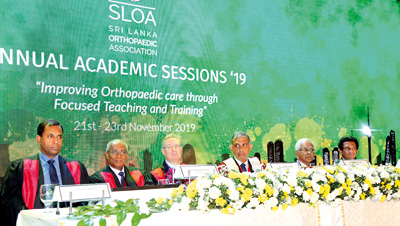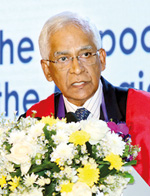News
Patient first
It was not just about treating injuries and diseases of our complex musculoskeletal system which includes bones, joints, ligaments, tendons, muscles and nerves, but an evening where the core of the healer’s vocation was put under the spotlight.

The eminent Orthopaedic Surgeons at the head-table at the inauguration (from left): Dr. R. Gnanasekeram (Treasurer), Dr. Vasantha Perera (Guest-of-Honour), Dr. Jose A. Morcuende (Chief Guest), Dr. Sunil Wijayasinghe (President), Prof. Benjamin Joseph (Orator) and Dr. K. Umapathy (Secretary).
The patient being in the very bones of those gathered for the inauguration of the 11th Annual Academic Sessions of the Sri Lanka Orthopaedic Association (SLOA) on Thursday night, was evident from all the passionate speeches delivered from the podium.
The inauguration of the two-day sessions on the theme ‘Improving orthopaedic care through focused teaching and training’ was at the Galadari Hotel in Colombo, while a pre-congress live operative workshop on unicompartmental knee was held at the National Hospital of Sri Lanka (NHSL) on Wednesday and a post-congress workshop on the ‘Current approach to the management of brachial plexus birth palsy’ is being held today at the Lady Ridgeway Hospital (LRH) for Children.
Setting the tone for the evening, the sessions and orthopaedic care in the country, SLOA President Dr. Sunil Wijayasinghe sent out a strong appeal for the strengthening of “correct goals” which ensured that the patients must come first; there should be professionalism at all times along with evidence-based practice and adequate skills, while maintaining ethical standards.
Quoting ex-American President Franklin D. Roosevelt, he said: “The test of our progress is not whether we add more to the abundance of those who have much, it is whether we provide enough for those who have little.”
He reiterated that their focus should becost-effective treatment suitable for the Sri Lankan setting and maintenance of standards of teaching and training, urging that with the increasing membership of the SLOA there may be challenges such as difficulty in achieving consensus and goals being different at times. “We need to be careful of personal agendas too.”
Tracing the improvements in orthopaedic care delivery over the years, Dr. Wijayasinghe said that in 1992 there were only 10 orthopaedic surgeons serving 17.5 million people, with just one surgeon for 1.75 million people. However, by 2019, 27 years later, there are 83 orthopaedic surgeons for 22 million people, with one surgeon per 265,000.
Orthopaedics in Sri Lanka is at an important juncture. General, arthroplasty, spinal, paediatric – which way should we go? The proposed sub-specialities are adult reconstruction & pelvi-acetabular fractures; orthopaedic oncology; foot & ankle; upper limb; arthroplasty; paediatrics; and spine, he said.
With society undergoing rapid transformation with changing goals, values and technological aids and having more access to information, Dr. Wijayasinghe had some pertinent advice to the younger generation. “The patient should come first and you should never lose your common sense and the humane touch. This is while you practise evidence-based medicine, encouraging the peer-review process and trying to do the correct thing at all times.”
The Guest-of-Honour, Dr. M. Vasantha Perera, said that over the last four decades, members of the SLOA have provided leadership and guidance in the training of orthopaedic surgeons. Sri Lanka can expect to have a total of around 140 orthopaedic surgeons soon which gives a ratio of one orthopaedic surgeon to 160,000 people. The internationally recognized ratio is 1 in 25,000.
While reflecting on the progress achieved, he also focused on the challenges ahead, placing them in two broad categories – improving training in special interest areas and providing optimal facilities to practise orthopaedics.
“During the last few decades, the field of orthopaedics has expanded and now includes a number of well-developed special interest areas. It is not possible for a single surgeon to have expertise in all these areas. Therefore, sub-speciality development is vital to provide better care to people,” he pointed out.

Dr. Vasantha Perera

Dr. Jose A. Morcuende

Dr. Sunil Wijayasinghe
This training, according to Dr. Perera, can be done either in separate sub-speciality units or by working with a surgeon who has a special interest in a particular area. Currently, there are only three sub-speciality units in the country – two for paediatrics at the LRH in Colombo and in Kandy respectively; and a spine unit at the Neuro-Trauma Unit of the NHSL, the only centre offering correction for spinal deformities.
“Ideally, there should be a paediatric unit in every teaching hospital and even though spinal trauma is managed in all orthopaedic units in the country, at present there are 43 children with adolescent idiopathic scoliosis requiring surgery. More units offering this service are a necessity and will also help in training in the sub-speciality of the spine,” he said.
“The second challenge is providing optimal facilities to practise orthopaedics. The siting of new orthopaedic units is decided by the Health Ministry with an input from the SLOA. These units are either duplications of already existing units in major hospitals or are in areas where access to an orthopaedic surgeon is difficult. These new units in difficult areas often have minimum facilities. The emphasis of these units is the basic management of trauma. Sub-speciality development is not a priority. Unfortunately, many of those who return after overseas training are posted to these newly-established stations where they do not have the opportunity to practise the skills they have learnt,” he said.
Dr. Perera added that with time, they are likely to lose the surgical skills for which they were trained. This is a tragedy as much time, effort and money have been expended on their training. The ongoing problems of lack of funding and infrastructure development need to be looked into.
Meanwhile, an impassioned plea went out from the Chief Guest and Director of the Ponseti International Association, University of Iowa, America, Dr. Jose A. Morcuende who spoke on the ‘Global impact of the Ponseti Method’ and how to overcome the condition of clubfoot.
“The Ponseti Method introduced to the world by Dr. Ignacio V. Ponseti, uses a series of gentle manipulations and plaster casts to return the foot to its normal shape and function,” he said, citing research to prove that this method contributed to an 85% reduction in surgery for children with clubfoot in the first year of their lives. Across the world, a child with clubfoot is born every three minutes.
Reminding the audience of the main elements of the Hipprocratic Oath such as ‘respecting the hard won scientific gains of those physicians in whose steps I walk in’; ‘avoiding the twin traps of over-treatment and therapeutic nihilism’; and that ‘warmth, sympathy and understanding may outweigh the surgeon’s knife’, Dr. Morcuende urged the adoption of the Ponseti Method and the setting up of Ponseti clubfoot clinics to reach all, as a major public health intervention.
| ‘Think of the patient as your own child – then clinical & ethical decisions come easily’ | |
| Love your patient, as you love yourself or your child. This was the simple message that Prof. Benjamin Joseph from the Aster Medcity Hospital, Kochi, India, gave in a measured but compelling delivery straight from the heart, during the SLOA Oration 2019.  Prof. Benjamin Joseph ‘The Hippocratic Oath, the Mosaic Law & the New Commandment’ was this eminent Consultant Paediatric Orthopaedic Surgeon’s intriguing theme, under which he underlined the need for clinical decision-making to be based on scientific evidence and ethical decision-making to be based on one’s conscience without commercial interests coming into play. With regard to decision-making in clinical practice, Prof. Joseph asked how one should make the correct choice when there were several different ways to treat a condition. There should be a template for decision-making which includes: listing the problems to be addressed; listing the aims of treatment; listing the treatment options for each problem; listing the merits and de-merits of each treatment option; and listing the factors that need to be taken into consideration while planning treatment for a particular patient. Taking up the case of an eight-year-old boy who presents with a recurrence of a deformity of the knee, he guided the audience on how a treatment plan could be formulated by using such a template, stressing that then “decision-making may not be too difficult even in complex situations”. “Yet,” he lamented, “all too often we see that the choice has not been the right one.” The reasons for the wrong choice in clinical practice, Prof. Joseph attributed to: Hyposkillia – deficiency of clinical skills. Those afflicted are ill-equipped to render good patient care, cannot take an adequate medical history, cannot perform a reliable physical examination, cannot critically assess the information they gather and cannot create a sound management plan, have little reasoning power and communicate poorly. Inadvertently following the path dictated by market forces. Deliberate choice of the wrong treatment for commercial gain. (He had this point with a pair of hands reaching out to a heap of coins.) He cited the instance of children who suffer a fracture of the clavicle, where many orthopaedic surgeons ignore evidence of the mainstay of management of such fractures in this age group being conservative management but resort to surgery due to industry dictates. Just because a car is coated in gold, does it run better, asked Prof. Joseph. Focusing on the Law of Moses (Mosaic Law) and the Ten Commandments, he said they encompassed Commandments relating to God and those relating to fellow human beings. However, the New Commandment dealt with just two aspects – ‘Love the Lord your God with all your heart, soul and mind’ and ‘Love your neighbour as yourself’. “All other commandments are superfluous because we all love ourselves and would never wilfully do anything that harms our own interests. If we love our neighbour as much as we love ourselves we could never harm their interests!” he said. Next, Prof. Joseph put the Hippocratic Oath under the spotlight, pointing out that it integrates respect for the teacher; commitment to teaching; commitment to purity; commitment to honourable conduct; commitment to patient confidentiality; commitment to do no harm; and commitment to shun corrupt practices (“whatever houses I enter, I will go into them for the benefit of the sick and will abstain from every voluntary act of mischief and corruption”). The dictionary definition of corruption was dishonest or illegal behaviour especially by powerful people (such as government officials or police officers); inducement to wrong by improper or unlawful means (such as bribery); and a departure from the original or from what is pure or correct. Modifying the Hippocratic Oath in the pattern of the New Commandment, Prof. Joseph said: “Treat every patient exactly how you (or your child or loved one) would like to be treated if you were in his/her situation. Ethical decision-making then becomes exceedingly simple.” He concluded with a description of how he attended a symposium on paediatric femoral fractures. Different speakers had extolled the virtues of different treatments – plaster spica; traction; external fixator; intra-medullary nail; and plate & screw. During the discussion, the audience had been told to give their preference and people had favoured one or the other, spread across all methods, mainly surgical options. The final question from the moderator had been which method they would choose if it was their child. One and all, without hesitancy, had raised their hand for plaster spica which was the conservative management method. Even for the distinguished audience in Colombo last Thursday this simple revelation said it all.
|

